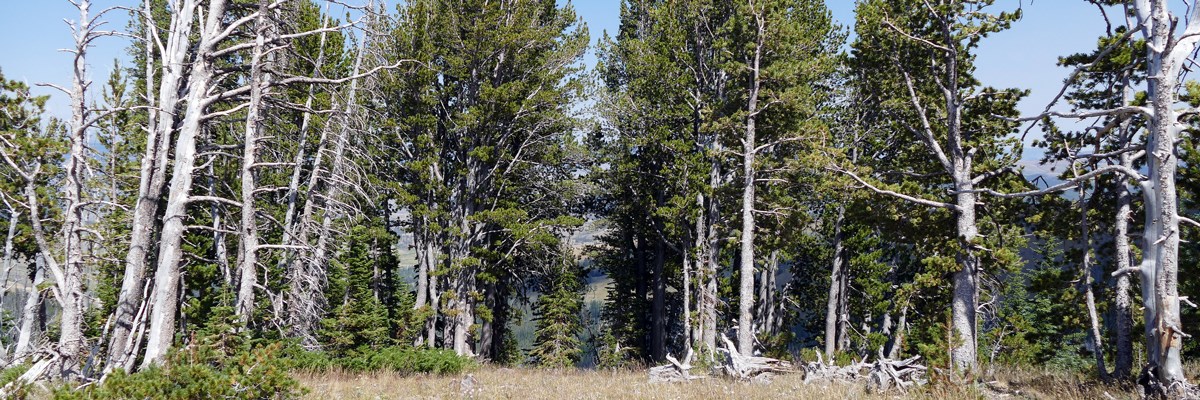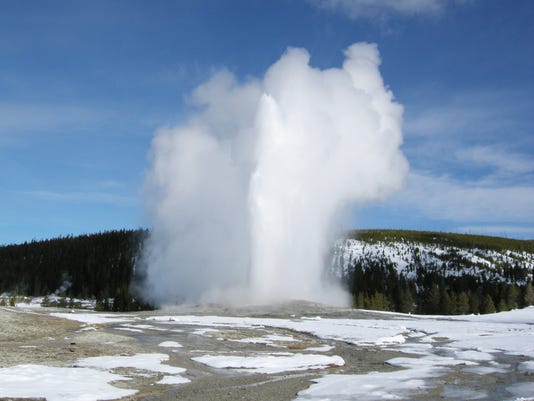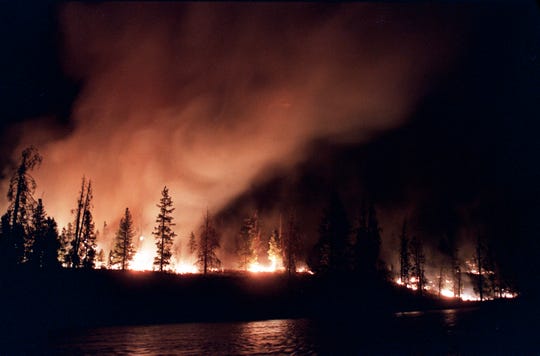Yellowstone, America's Geothermal Ecological Wilderness
"You run into visitors and they thank you for the place. They are seeing elk and antelope for the first time in their lives."
"When I first started doing it [poring over weather data three decades ago], I really thought climate change was something that was going to happen to us in the future. But it is one of those things where the more you study it, the more you realize how much is changing and how fast."
"All of a sudden it hits you that this is a really, really big deal and we aren't really talking about it and we aren't really thinking about it."
"This is what we don't want [invasive species to take hold] -- to turn into what it looks like in Gardiner [Montana]. The seeds come in on people's cars and on people's boots. [Cheatgrass can ignite] like tissue paper. It can suck the moisture out of the ground early [in spring]. Then it is gone, so it doesn't sustain animals throughout the summer the way native grasses would."
Ann Rodman, park scientist
 |
| Whitebark pine trees, living on the edge in high elevations, are vulnerable to climate change.
NPS / Diane Renkin
|
"It is a very interesting mix of land-use change and climate change, possibly leading to quite dramatic shifts in migration and to thousands of elk [ending up migrating in search of food] on private land."
Andrew J. Hansen, Montana State University
"[By the end of the century], the weather like the summer of '88 will likely be there all the time rather than being the very rare exception."
"As the climate is warming, we are getting fires that are happening more often. We are starting to have the young forests burn again before they have had a chance to recover [from previous fires]."
The structure of the forests is going to change. They might become sparse or not recover if we keep doing a double and triple whammy."
Monica G. Turner, University of Wisconsin-Madison
"We can very definitely see warming trends during the summer and fall."
"Stream and river flows are declining as snowpack declines."
Daniel J. Isaak, United States Forest Service
 |
| This Nov. 21, 2016, file photo shows Emigrant Peak towering over the Paradise Valley in Montana north of Yellowstone National Park. |
Yellowstone has the great distinction of representing the first national park in the United States, declared so in 1872. It is a world heritage site, recognized by UNESCO. But in the area of 89,000 square kilometers of the Greater Yellowstone Ecosystem which includes the park, national forests and Grand Teton National Park, the overall temperature since 1948 has risen about one degree Celsius resulting in a ten-day shorter and less cold typical winter. "For the Northern Rockies, snowpack has fallen to its lowest level in eight centuries", forest and climate change scientist Patrick Gonzalez at the University of Berkeley stated.
Even should rainfall increase in the future, park summers have become warmer, drier and incendiary-prone, so that increased rainfall would evaporate under these conditions more quickly. "By the time my daughter is an old woman, the climate will be as different for her as the last ice age seems to us", explained Michael Tercek, an ecologist whose work in Yellowstone is reflected in a 28-year career. Yellowstone's landscape is volcanic, exemplified in cold streams and hot springs, snow and steam where magma incites boiling water and multihued thermophiles (bacteria which thrive at high temperatures).
 |
| Old Faithful eruption. Yellowstone National Park |
Yellowstone is the very epitome of the American wilderness with its vast open skies under which antelope and bison roam. But it is also a place now where nutritious native grasses, burned out after successive fire events have been aggressively replaced with non-nutritive grasses like cheatgrass and desert madwort, the interloping invasive plants taking the place of the ecosystem's native plants.
Bison and elk depend for their browsing on the native plants that grow in the geology that is their habitat. Cheatgrass offers them nothing.
Resulting in lost forage that occurs when drier and hotter summers shorten what is called by ecologists the green wave, where plants green up at various times at different elevations to feed the large animals who in their absence must look elsewhere for their sustenance. That elsewhere can be in valleys outside the park where they nibble at lawns and alfalfa fields. When elk leave the park wolves follow. Yet another threat to the ecology of the system is fires becoming a greater problem echoing conditions that enabled 1988's fires when a third of the park burned.
 |
| A forest fire blazes out of control in Yellowstone National Park on Sept. 2, 1988. The blaze eventually burned 36 percent of the park. (Photo: AP) |
Repeated fires could conceivably result in more grassland. Forests are known to shade waterways but since young trees have few cones there are fewer seeds to release to regrow new forests if the cones even survive the heat. When fish become concentrated in smaller areas the transmission of disease is eased; the Yellowstone River famous for its fly fishing and cutthroat trout had closed to anglers in 2016 in response to the death of thousands of fish from a kidney disease. The nesting of water birds such as loons, American white pelicans, double-crested cormorants and trumpeter swans are all affected when swiftly melting snow in early spring turns into torrential waves of meltwater.
The entire ecosystem begins to suffer when climate change starts its inroads on whitebark pine where warmer temperatures has seen the mountain pine beetle surviving winter and moving into high elevations and gaining a longer reproductive season. An estimated 80 percent of whitebark pines in the park in the last three decades have perished by fire, beetle or fungal infections. The trees colonize exposed mountain sites so other understory plants can root in their protective presence. Their wide canopies shelter snowpacks from the warming effect of the sun.
And food is provided for birds such as the Clark's nutcracker, a bird that creates whitebark pine nurseries by caching nuts. Those nuts represent an important source of food for squirrels, foxes and grizzlies. So that when the availability of nuts is impacted, bears which are omnivores, look elsewhere to fill the food gap and that includes the relisted-as-threatened-species grizzlies searching elsewhere. Elsewhere can include the discarded intestines of hunted-outside-the-park deer and elk, drawing the bears toward human habitat where the challenge of proximity to both humans and bears makes each vulnerable.
 |
| A grizzly bear roams near Beaver Lake in Yellowstone National Park, Wyo., July 6, 2011. Jim Urquhart, AP |
"[The loss of the pines] has far-reaching implications for the entire ecosystem."
"The rest of the landscape, even in the mountainous West, has been so altered that Yellowstone becomes even more important."
Jesse A. Logan, retired Forest Service researcher
 |
| Global Observation Research Initiative In Alpine Environments (GLORIA) is a world-wide long-term monitoring network with sites in the park. National Park Service |
Labels: Climate Change, United States, Yellowstone National Park

0 Comments:
Post a Comment
<< Home